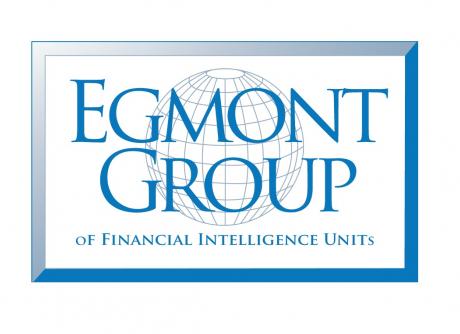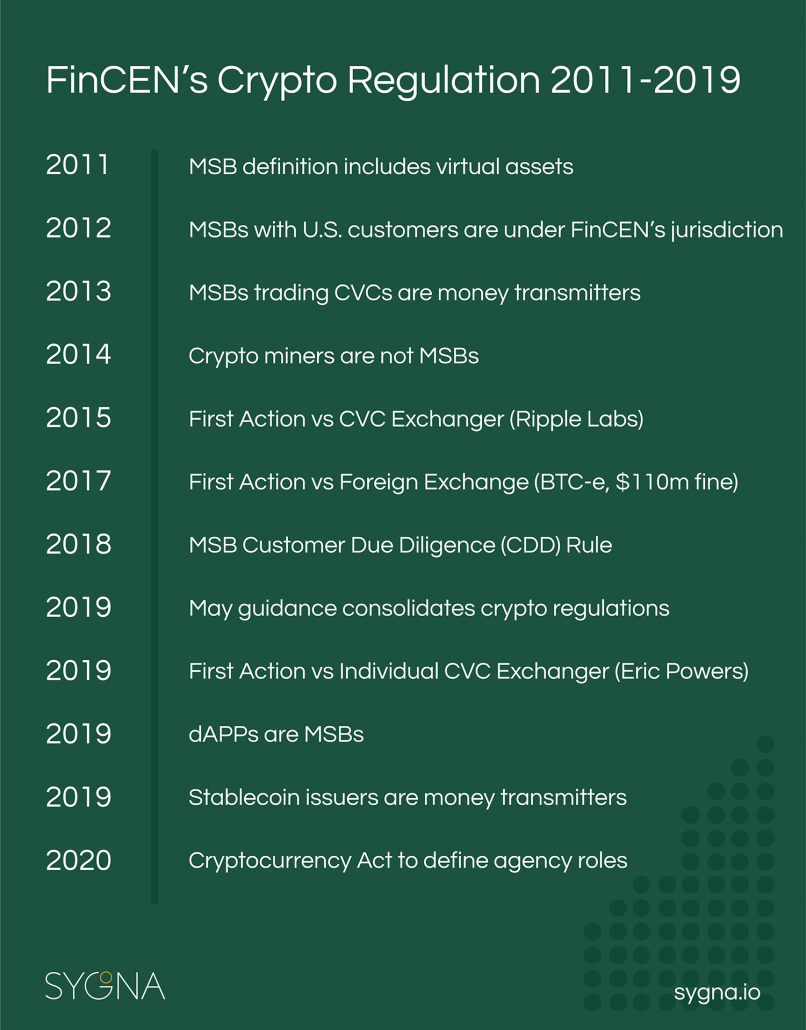- Introduction
- What is FinCEN? (History, Mission, Organization)
- FinCEN and the Bank Secrecy Act (BSA)
- FinCEN’s duties to the U.S. Congress
- FinCEN and U.S. government agencies
- FinCEN and international FIUs
- FinCEN’s organization
- FinCEN and virtual currencies
- Conclusion
Introduction
In 2019, two organizations dominated cryptocurrency regulation headlines. The Financial Action Task Force (FATF) and the Financial Crimes Enforcement Network (FinCEN) are mandated by the G7/G20 and U.S Treasury respectively to fight illicit financial behavior through its anti-money-laundering and combating-financing-of-terrorism policies, collectively referred to as AML/CFT, and their actions in 2019 showed they meant business when it comes to effectively regulating virtual assets in 2020 and the new decade.
In May 2019, FinCEN took a strong stance against Money Service Businesses (MSBs) who did not follow legal procedures when dealing with convertible virtual currencies (CVCs). In June 2019, at the end of a 1-year U.S. presidency, the FATF adopted the FinCEN’s information-sharing blueprint to regulate crypto transactions in their update to Recommendation 16 on Wire Transfers, now often referred to as the FATF’s “crypto travel rule”.
In this article, we’ll take a closer look at the importance and influence of FinCEN, its history, purpose, organization, collaboration with other international financial investigation units (FIUs) and specifically, its approach and recent actions regarding virtual assets.
What is the Financial Crimes Enforcement Network (FinCEN?)
The Financial Crime Enforcement Network (FinCEN) is a bureau of the United States’ Department of the Treasury. Headquartered in Vienna, Virginia, FinCEN was created in April 1990 by the Treasury as a government-wide network to analyze intelligence from multiple sources in order to help detect, investigate and prosecute both domestic and international cases of money laundering and other financial crimes.
In response to the horrific 911 terrorist attacks, the Treasury awarded FinCEN official bureau status in accordance with the USA Patriot Act of October 2001.
FinCEN forms part of the Treasury’s Office of Terrorism and Financial Intelligence (TFI).
Who is the head of FinCEN?
The current FinCEN director is Mr. Kenneth A. Blanco, elected in December 2017. Mr. Blanco is an outspoken proponent of the regulation of virtual assets in accordance with the BSA. The FinCEN director reports to the Secretary of the Treasury and is authorized to implement, manage and enforce measures that ensure compliance with BSA and other regulations.
What is FinCEN’s mission?
FinCEN’s official mission is to “safeguard the financial system from illicit use and combat money laundering and promote national security through the collection, analysis, and dissemination of financial intelligence and strategic use of financial authorities.”
It is the appointed protector and enforcer of the United States’ Bank Secrecy Act (BSA) of 1970, a seminal piece of legislation that has influenced other financial laws. The BSA is frequently updated to help law enforcement and regulators combat financial crime as effectively as possible.
What is the purpose of FinCEN?
FinCEN’s operations are succinctly summated by its well-known motto: “Follow the Money.”
The organization essentially has two overarching purposes. It serves as the United States’ primary1) Financial Intelligence Unit (FIU) and 2) Anti-Money Laundering/Combating Financing of Terrorism (AML/CFT) regulator for the federal government
FinCEN fulfils its mandate by collecting, maintaining, analyzing and sharing financial transmittal data in order to help AML/CFT enforcement, and working with country-level and global counterparty organizations such as the Financial Action Task Force (FATF).
How does FinCEN “follow the money”?
FinCEN traces the flow of money by gathering and analyzing financial transaction data in order to detect and punish illicit financial behavior.
As America’s leading FIU, FinCEN works closely with both its domestic and global financial industry. It uses the powerful U.S. Bank Secrecy Act (BSA) to force financial institutions such as banks to compile reports and keep records of all transactions, which the agency uses as a financial trail to investigate and track financial criminals and the movement of their assets.
Firstly, the bureau makes sure that financial institutions issue Suspicious Activity Reports (SARs), also known as Suspicious Transaction Reports (STRs) in accordance with the BSA’s requirements. FinCEN collects these reports in order to identify “emerging threats to the global financial system by looking at traces of possible money laundering or terrorism funding.
Secondly, FinCEN supports law enforcement activities by providing intelligence and analytics and aims to optimally share relevant information between various law enforcement agencies.
The crime enforcement network combines BSA reports with public and government-issued information which it then disseminates amongst law enforcement agencies to enhance financial investigations and AML/CFT strategies.
FinCEN and the Bank Secrecy Act (BSA)
FinCEN regulates financial institutions in accordance with the Currency and Financial Transactions Reporting Act of 1970, which was updated by the USA PATRIOT Act Title III (2001) and is better known as the Bank Secrecy Act (BSA).
The BSA is the United States’ most important federal AML/CFT statute and allows the Treasury Secretary (currently Mr. Steven Mnuchin) to regulate financial institutions and banks through issuances that that establish a proactive AML/CFT regime, which may include the likes of required transaction reports and AML programs.
FinCEN’s BSA Travel Rule
On 28 May 1996, FinCEN started to enforce its so-called Travel Rule, as enacted in the Bank Secrecy Act (BSA) rule [31 CFR 103.33(g)]. The Travel Rule forces financial institutions to forward specific transmittal information to the next financial institution, where transaction amounts exceed USD 3,000.
The Travel Rule works in tandem with the BSA recordkeeping rules [31 CRF 103.33(e) and (f) for funds transfers and transmittals] and helps law enforcement to investigate and prosecute financial crime offenders by creating an information trail of transactions.
FinCEN’s duties to the U.S. Congress
FinCEN has specific duties and responsibilities as dictated by the U.S. Congress, in order to assist its Federal, State, domestic and global government and financial industry partners.
In order to detect and deter illicit financial behavior, FinCEN:
- Issues, interprets, supports and enforces statute-approved regulations
- Assists, coordinates and dissects other Federal regulators’ compliance examination duties
- Manages, stores, shares and protects all BSA-required reported data
- Makes its data accessible government-wide to other network users with a common interest
- Supports law enforcement investigations and prosecutions
- Recommends how federal agencies should best allocate their resources, based on the greatest financial crime threats
- Cooperates with foreign FIUs by sharing information and coordinating on AML/CFT activities
- Analyzes data in order to assist lawmakers, regulators, intelligence agencies, law enforcement and the financial industry as a whole.
How does FinCEN help other government agencies?
FinCEN provides support to over 165 financial, law enforcement, and regulatory agencies at federal, state and local governments. On average, it annually issues about 6,500 intelligence reports.
FinCEN is able to provide a 30,000-foot view to these smaller organizations thanks to its plethora of data, cutting-edge technology and FIU network, helping them to connect the dots and solve financial crimes that often cross physical and digital borders where they have no jurisdiction or know-how.
In the States, FinCEN boosts state and local law enforcement by giving them access to their comprehensive database through Project Gateway, thus allowing individual states direct access to information crucial to investigations.
How does FinCEN cooperate with the FATF and global FIUs?
While FinCEN is tasked with deterring and fighting U.S. money laundering, it has assumed a senior leadership position in the global AML/CFT regulatory hierarchy. Most notably, the Financial Action Task Force (FATF) adopted an update to their Recommendation 16 in June 2019 that basically mirrors that of the BSA’s “Travel Rule”. At the behest of the U.S. FATF president for 2018/2019, Marshal Billingslea, member countries must now ensure that virtual asset service providers (VASPs) share recipient and beneficiary information with each other.
FinCEN also cooperates with other countries’ FIUs, such as the UK, France, Australia and other members of the Egmont Group, an international network of 164 FIUs that coordinate efforts to fight criminal financial behavior. The federal bureau acts as a “conduit” for U.S. agencies who need to connect with international FIUs in order to conduct cross-border investigations.

The FinCEN Organization
FinCEN has about 300 employees, the majority permanently employed, working in six divisions. An additional 20 FinCEN members are assigned from 13 other government agencies and are usually elite intelligence, financial and technology specialists. The FinCEN Director is appointed by the Secretary of the U.S. Treasury (currently Mr. Steven Mnuchin) and must report to its Under Secretary for Terrorism and Financial Intelligence (TFI), currently Mr. David S. Cohen.
What are the 6 FinCEN divisions?
- Intelligence- transactional issues and analytical research
- Enforcement- compliance, special measures and investigations
- Policy-regulatory and strategic policy
- Liaison- Operations, stakeholder engagement, resource center
- Technology- Data security, analytics and management; infrastructure
- Management- Financial, HR, Security, Leadership, Employee development
FinCEN’s Approach to Virtual Currencies
Due to FinCEN’s relatively lax response to cryptocurrency transactions, many investors and companies mistakenly believed for years that FinCEN and the BSA’s regulations did not apply to virtual assets.
In November 2019, FinCEN director Ken Blanco issued a stark warning to crypto companies that they are not above the law and cleared up any ambiguity. Blanco said crypto companies who are classified as money service businesses (MSBs) have been required since 2011 to ensure that they comply with the BSA’s travel rule and other regulatory measures and will face severe consequences in the future if they don’t.
Here follows a short overview of FinCEN’s relationship with virtual assets.

July 2011- MSB definition amended to include virtual assets
In its regulatory update Definitions and Other Regulations Relating to Money Services Businesses, FinCEN changes its definition of money service businesses (MSBs), companies that fall under its regulatory scope, to include virtual currencies through the phrase “other value that substitutes for currency”,
February 2012 guidance – MSBs with U.S. customers
MSBs who deal with U.S. customers are subject to FinCEN regulations, irrespective of where they are based.
March 2013 Guidance- MSBs who deal with CVCs are money transmitters
FinCEN’s director declares that virtual currencies are the same as traditional currencies and that MSBs (but not users) who deal with convertible virtual currency (CVC) are defined as money transmitters, and must, therefore, comply with AML/CFT regulations by keeping and reporting transaction records and registering with FinCEN.
May 2015- First Action vs CVC Exchanger: Ripple Labs fined $700k
After launching its XRP token and failing to register as MSB, Ripple Labs are penalized by FinCEN in what it described as the “First Civil Enforcement Action Against a Virtual Currency Exchanger”.
July 2017 – First Action vs Foreign Exchange: BTC-e fined $110 million
In this groundbreaking ruling, the U.S Treasury by way of FinCEN takes its first action against a foreign-based MSB by fining the controversial virtual currency exchanges BTC-e a staggering $110 million for operating without a license and conducting criminal behavior. The exchange’s founder Alexander Vinnick is as of January 2020 still awaiting extradition from Greece to France and is still being sought by the U.S. for laundering nearly $4 billion.
FinCEN and virtual currencies in 2019
With the U.S.’s presidency of the FATF providing an opportune time to establish a strong and cohesive global framework for the AML/CFT regulation of virtual assets, FinCEN became noticeably more active towards the crypto industry in 2019.
April 2019: First Action vs Individual Crypto Trader – FinCEN fines Eric Powers
In April 2019-FinCEN penalizes an individual for the first time for failing to register as a money service business, in a move that shocks the crypto industry.
May 2019: FinCEN ties together a decade of policy crypto regulations
In May 2019, FinCEN consolidates nearly a decade of previous statements on virtual currencies (2011-2019) in a detailed interpretive guidance. FinCEN’s CVC guidance, Regulations to Certain Business Models Involving Convertible Virtual Currencies, warns crypto businesses that they are in fact MSBs due to their transacting with CVCs, and are therefore in breach of the BSA if they don’t register and adhere to FinCEN policies.
FinCEN further takes aim at decentralized applications (dAPPS) and says some of them are in fact also MSBs and therefore under their jurisdiction.
October 2019: FinCEN, SEC and CFTC join forces
In October 2019, FinCEN issues a joint statement with the U.S. Securities and Exchange Commission (SEC) and U.S. Commodity Futures Trading Commission (CFTC) to provide a united AML/CFT front and explain how they view the regulation of digital assets.
November 2019: Stablecoins are money transmitters; crypto MSB’s must comply with Banking Secrecy Act
In November 2019, FinCEN declares that stablecoins like Libra are also to be classified as “money transmitters”. In addition, he made it clear that virtual asset companies who qualify as money service businesses (MSBs) have been required since 2011 to comply in full with Banking Secrecy Act (BSA) regulations such as its “travel rule”.
December 2019- Cryptocurrency Act of 2020 proposed
In late December 2019, a new bill, dubbed the Cryptocurrency Act of 2020, has been proposed to the United States’ Congress. If accepted, it will allocate specific regulatory mandates to various federal agencies. The act anoints FinCEN, the SEC and CFTC as the leading digital asset regulators in the federal government.
Conclusion- FinCEN and virtual assets in 2020
With 2020 and the new decade here, it’s clear that FinCEN has the crypto industry in its crosshairs and that unbridled unregulated and illicit behavior will no longer be tolerated. Thanks to the incoming Cryptocurrency Act 2020, FinCEN will enjoy more powers and better synergy with fellow governmental bodies such as the IRS, CFTC and SEC. Also, FinCEN will continue to foster closer ties and better coordinate their efforts with international regulators and financial investigative units (FIUs) such as the FATF, in order to stamp out money laundering and criminal activities that use virtual currencies.
The effects of FinCEN’s growing presence in the crypto industry was strongly felt in 2019, with many virtual asset service providers opting for better AML/KYC solutions, rewiring their business structures ( such as Binance’s new U.S. exchange) or ceasing their services to US customers.
Authorities worldwide are now pulling their resources together in order to eradicate money laundering, terrorism financing, and fraud. The crypto industry can expect increasingly strict regulations from the likes of FinCEN and the Financial Action Task Force that will act as deterrents and guidances to the industry at large.
Written by Werner Vermaak
About CoolBitX and Sygna Bridge
CoolBitX’s Sygna Bridge is a first-to-market travel rule solution and alliance network that is live and being used by our VASP partners to share compliant originator and beneficiary transmittal information.

Sygna Bridge completed a successful production test report (Big 4 audited) earlier this year, which was presented to the FATF Contact Group in May 2020. Sygna Bridge now also supports the IVMS101 messaging standard.
CoolBitX has signed MoUs with over VASPs worldwide and recently joined forces with Elliptic in a combined quest to help crypto companies comply with the FATF Standards.
For enquiries on the FATF Travel Rule and our Sygna Bridge solution for VASPs, please contact us at [email protected].
Disclaimer: CoolBitX provides these blog posts for general educational purposes only. Information on this blog does not constitute professional legal or financial advice and should not be considered as such. The author or company may update the information on this article at any time without prior notice and do not guarantee the work to be up to date and accurate. To the best of our knowledge the information provided here is factual at the time of writing.


